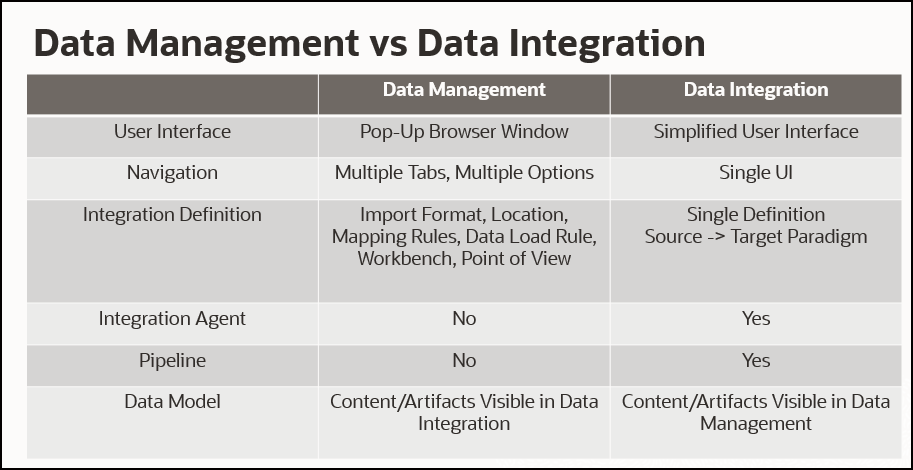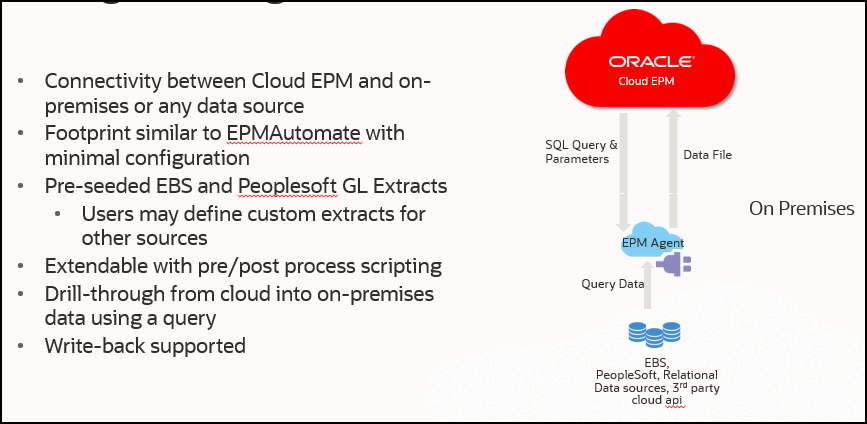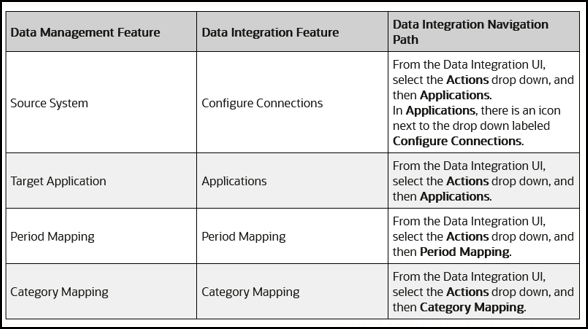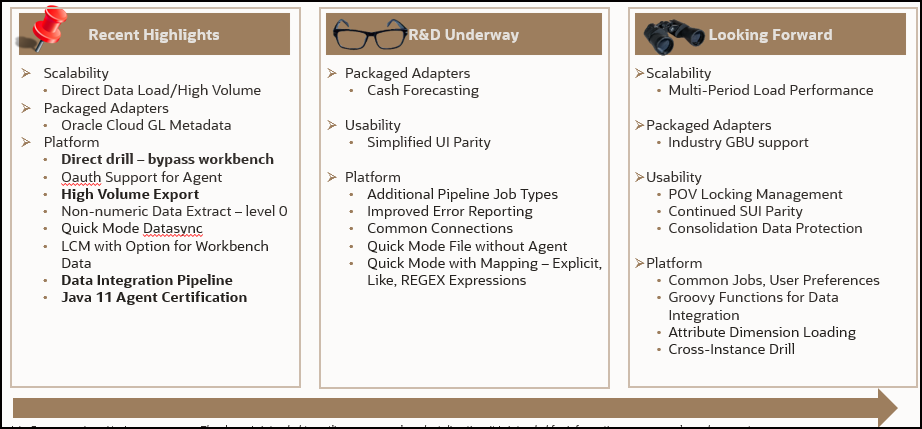Enterprise Performance Management Data Management to Data Integration
Thank you to Mike Casey for the information on this blog!
Data Integration – Next Generation UI

EPM Integration…Source, Target and Transformations
Data Management vs Data Integration

EPM Integration Agent

Why is the EPM Integration Agent so important?
- Eliminates the need for on-premises FDMEE
- Provides connectivity to everything/anything
- SQL for on-premises sources
- Scripting extensions to call any 3rd party API
- Workday, SFDC, etc.
- Users decide where/how to drill
- Drill into source data with or without a URL
- Load detail into Cloud EPM, or maintain on source
- Drill to Fusion UI using Deeplinks
Data Maps and Smart Push
- Available from within Data Exchange
- Move data, comments, attachments and supporting detail across cubes
- Assign Data Maps to forms as a “Smart Push” form property to move data when a form is saved
- Cross application Support
- Planning, Freeform, Enterprise PCM as source
- All Essbase targets supported
Important Announcement
Starting with the September (23.09) update, the following features will no longer be available in Data Management, but will be available in Data Integration. Data Integration is available from the Data Exchange card from the home screen in the Cloud EPM Business Process, and users can access these features in the current Cloud EPM update
Migration from Data Management to Data Integration is NOT required

Quick Mode Data Load
- High Volume Data Imports
- Eliminates most Data Integration overhead
- Database and file sources using the Integration Agent
- Expressions for transformations supported
- Within or between business processes (Essbase only)
Quick Mode Data Export
Includes the following options:
- All Data
- MDX – Best for Hybrid or ASO with filters
- Level 0 Data
- MAXL – Best for high volume ASO
- Stored Data Only
- DATAEXPORT – Best for BSO
- Stored and Dynamic Calculated Data
- DATAEXPORT – Best for BSO
- All options use Expressions
- EPMAutomate not available
- Use runIntegration REST API
- INTEGRATION job type, import mode DIRECT and export mode REPLACE
Launch an Integration using Groovy
- Define Connection for reference in Groovy
- Call REST API from Groovy based Business Rule
- Execute Business Rule to launch integration
Performance Tuning/Options
- Workflow Mode
- Full – All events, TDATASEG_T and TDATASEG and Drill
- Full No Archive – All events, but TDATASEG deleted after load. No drill
- Simple
- Import and Export Steps only
- Mapping but no validations
- No Workbench data, no drill
- Process Tuning
- Consider the use copysource Expression
- Convert * to * to SQL map
- Quick Mode
- Bypasses majority of processing overhead
- Expressions supported for mapping
- Available for import and export
- New Performance Tuning chapter in documentation
SAP Integration Considerations
- Flat File
- SAP Basis team exports required data to flat file
- Stage for use by EPM
- Orchestrate with EPMAutomate or REST
- Data Integration
- Use Agent with scripting to make function calls to SAP
- Use agent with JDBC driver to directly access SAP tables
- Check SAP contract for direct access details
- Orchestrate flat file approach with Agent
- Oracle Integration Cloud
- SAP Adapter documentation available here
- Use OIC REST adapter to connect to EPM
JD Edwards Integration Considerations
- Flat File
- JDE Team provides data extract
- Stage for use by EPM
- Orchestrate with EPMAutomate or REST
- Integration Agent
- Use Agent with Data Access Driver (DAD)
- Learning path available that provides integration example here
- Oracle Integration Cloud
- JDE Adapter documentation available here
- Use OIC REST adapter to connect to EPM
Custom Data Integration Reports
- Data Integration/Management reports are read-only
- Task Manager reports support custom reporting
- Available against the Data Integration relational database
- Provide query and report template
- Use FDMEE queries and reports “as-is”
- Task Manager reports are available in all business processes
Oracle EPM: Data Integration – Oracle Safe Harbor applies
